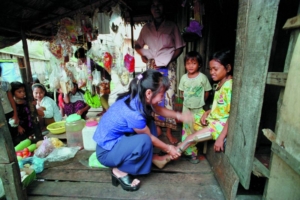3D-Printed Prosthetic Limbs in Cambodia

Cambodia is one of the most heavily mined nations due to conflicts between the 1970s and 1990s. It has the highest proportion of landmine survivors, with more than 9,000 people in need of artificial limbs.
The landscape of disability is evolving with an increase in cases resulting from traffic accidents, workplace incidents and diseases related to changing lifestyles, such as type 2 diabetes and cardiovascular conditions.
The demand for prosthetics in Cambodia is profound, with an estimated 1.6 million people living with disabilities and little access to assistive devices, leaving individuals trapped in a lifelong cycle of poverty.
3D-printed prosthetic limbs in Cambodia have emerged as a revolutionary solution for amputees in the most disadvantaged and marginalized populations.
The Solution
The loss of limbs presents significant challenges for individuals. Traditional solutions like wheelchairs are impractical due to poor road conditions in Cambodia. Thus, the absence of prosthetic limbs leaves individuals unable to participate fully in areas such as education, work, community endeavors and daily life activities. As such, the lack of access to affordable prosthetic limbs deepens poverty, especially in a country with a poverty rate that already stood at around 18% in 2019/2020, according to the World Bank.
Cutting-edge 3D-printing technology has transformed the medical field making prostheses as accessible and useful as possible. It offers a rapid and cost-efficient creation of custom prosthetics. For example, one traditional below-the-knee prosthetic can cost from $1,200 to $5,000 and take up to three weeks to make.
However, 3D-printed prosthetics can cost as little as $50 in comparison and can be produced in a day. Therefore, enabling Cambodia to obtain inexpensive prosthetics helps overcome challenges that traditional prosthetic production in this developing nation once faced.
Exceed Worldwide
Exceed is a British charity established in 1989 at Cambodia’s government’s request to assist landmine survivors across five Asian countries. Its mission centers on training individuals free of charge in the art of providing prosthetics and orthotics with a focus on improving the lives of those in need.
For those individuals who can afford it, profits from paid services go towards funding free programs for the most disadvantaged who cannot afford it. The charity thus enables access to prosthetics and orthotics, and allows individuals with lower limb disabilities to experience acceptance and confidence and finally break free from a lifelong cycle of poverty.
Exceed Worldwide Partnerships
Exceed embarked on a transformative journey in 2017 by initiating a seven-month trial in Cambodia in collaboration with a Canadian nonprofit organization, Nia Technologies. It originated in 2015 with a specific focus on orthopedic clinics in resource-poor countries to help clinicians make prosthetics faster and more affordable than traditional methods. This system is designed to align with the existing International Committee of the Red Cross (ICRC) polypropylene technology to manufacture prosthetic devices. Polypropylene is traditionally chosen in developing nations, as it is cheap, requires few materials in the manufacturing process thus is easy to process and versatile.
This ground-breaking aspect of 3D scanning and printing technology in Cambodia generates digital replicas of limbs in a mere half-hour, avoiding the mess associated with traditional methods. The trial, which involved 60 Cambodian children, employed a technology called “3D Print Ability.” It uses a sophisticated integration of computer-aided design and manufacturing (CAD/CAM), scanning, modeling and printing. This process reduces the production of below-the-knee sockets and leg braces to just three days.
Its success in the trial has highlighted the potential for global implementation in Exceed centers worldwide, promising individuals in resource-poor countries more access to devices to help them walk.
Victoria Hand Project
The Victoria Hand Project is a Canadian prosthetics NGO, transforming lives through 3D printing in Cambodia to craft personalized prosthetic hands, revolutionizing the entire prosthetic process for increased efficiency and affordability. The project establishes clinics and equips 3D printers to local communities. This initiative empowers and trains individuals. It offers comprehensive training on printer usage, prosthetic assembly and software utilization.
In 2016, the project forged a significant partnership with ARC Hub PNH, Cambodia’s pioneering 3D printing firm founded in 2013, and the Siem Reap Physical Rehabilitation Centre. Together, these collaborative efforts have resulted in the successful fitting of functional prosthetic hands on upper-limb amputees costing $300 and taking around 40 hours to print.
In 2019, alone around 25 amputees have benefited from Victoria Hand Project’s prosthesis systems. This represents a tangible step toward empowerment and highlights the project’s commitment to making a meaningful difference to Cambodian victims of landmine explosions.
Future Revolution
The adoption of 3D-printed prosthetic limbs in Cambodia marks a ground-breaking advancement in both medical innovation and humanitarian assistance. Key charities have played pivotal roles in transforming the lives of amputees in Cambodia. These initiatives have efficiently addressed the urgent needs of amputees while promoting self-sufficiency and empowerment within local communities.
This collaborative approach, uniting international organizations, local partners and innovative technologies, has made a significant social impact in Cambodia. The success of these efforts highlights the transformative potential of technology in healthcare for developing nations while also demonstrating the power of collaboration and innovation in addressing complex societal challenges.
These initiatives serve as inspiring examples of how advanced technology is reshaping Cambodia’s narrative. It brings positive change and improves the quality of life for people with disabilities while reducing their risk of falling into poverty as it allows them to engage in productive and developmental activities such as education and employment.
– Ellen Jones
Photo: Flickr
